


EIS Frequency:10μHz~8MHz Especially developped for solid-state eletrolyte material research
Key specifications:

Single-channel potentiostat/galvanostat with EIS Model CS360 consists of a DDS arbitrary function generator, a potentiostat /galvanostat and an FRA. With the help of built-in dual 24-bit Delta-sigma AD converters, it achieves excellent stability and high potential (1mV) and current(1pA) resolutions.With EIS frequency up to be 8MHz, CS360 has been an ideal tool for the study of solid-state electrolyte.
Applications
– Energy materials (Solid-state battery, Li-ion battery, solar cell, fuel cell, supercapacitors, etc)
– Electrocatalysis (HER, OER, ORR, CO2RR, NRR, water splitting)
– Reactive mechanisms of electrosynthesis, electrodeposition (electroplating), anodic oxidation, electrolysis
– Metallic corrosion; corrosion inhibitor, coating and cathodic protection efficiency

With virtues of high energy density, fast charging &discharging, and long lifespan, solid-state batteries are widely used in electric vehicles, wearable devices and so on. Featured by leak-proofness, flame retardancy and inhibition of dendrite growth, solid-state electrolytes enhance the safety of batteries. ElS is an important technique to study the performance of solid-state batteries. It can provide information about charge transfer, electrochemical reactions, etc by measuring EIS in various frequency regions, further providing important theoretical basis and technical support for the development of high-performance fully solid-state batteries.
The EIS frequency can be up to 8MHz for CS360 electrochemical workstation, which can meet the need of high-frequency EIS test on solid electrolytes. Study of solid electrolytes especially focus on impedance behavior in high-frequency region. It helps us to quantify the electronic &ionic conductivity, find microstructural problems of the material (such as grain boundary effects), and thus provide guidance on material optimization, and battery performance improvement.
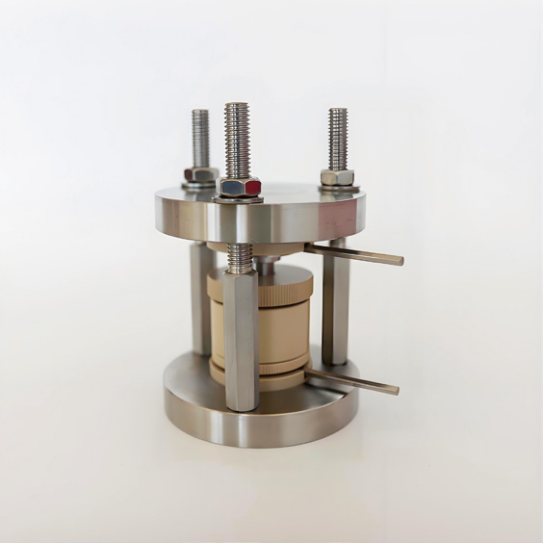
Solid-state battery holder
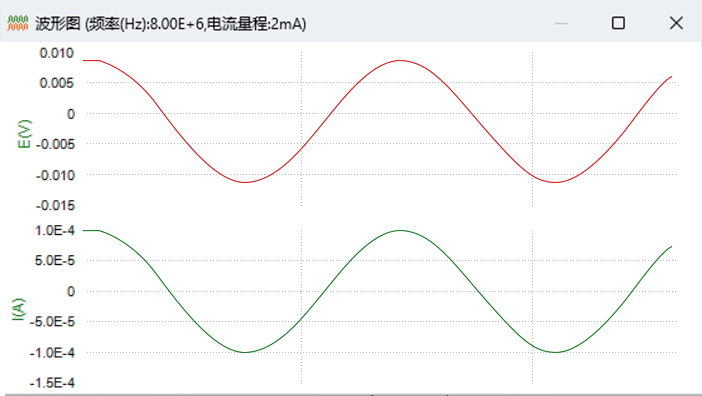
Waveform of the EIS test
Specifications – CS360
Support 2-, 3- or 4-electrode configuration
Maximum applied Potential: ±10V
Maximum output current: ±2A
Potential control accuracy: 0.1%×full range±1mV
Current control accuracy: 0.1%×full range
Potential resolution: 1μV
Current sensitivity:1pA
Potential rise time: ≤1μs
Reference electrode input impedance:1013Ω||5pF
Input basis current: ≤10pA
Potential range: ±200mV, ±2.5V, ±5V, ±10V, 4 ranges
Current range: ±200pA ~ ±2 A, 11 ranges
Compliance voltage: ±30V
CV and LSV scan rate: 0.001mV/s~10kV/s
CA and CC pulse width: 0.0001~65,000s
Current increment during scan: 1mA@1A/ms
Potential increment during scan: 0.02mV @1V/ms
SWV frequency: 0.001~100kHz
DPV and NPV pulse width: 0.001~100s
AD data acquisition: 16bit@1MHz, 20bit @1kHz
DA Resolution: 20 bit
Minimum Potential increment in CV: 0.02mV
Low-pass filters: covering 7-decade
Potential and current range: Manual/Auto switch
Ground mode: Floating, Earthing, supports ZRA
Communication: USB2.0, RJ45 Ethernet
Operating System: Windows 10/11
Power supply: 90~240V AC 50/60Hz
Weight / Dimensions : 6.5kg, 36 x 30 x16 cm
EIS (Electrochemical Impedance Spectroscopy)
Signal generator
Frequency range:10μHz~8 MHz
AC amplitude: 1mV~2500mV
DC Bias: -10~+10V
DDS output impedance: 50Ω
Frequency accuracy: 0.1%
Signal resolution: 0.1mV RMS
Waveform: sine wave, triangular wave and square wave
Wave distortion: <1%
Scanning mode: logarithmic/linear, increase/decrease
Signal analyzer
Integral time: minimum:10ms or the longest time of a cycle
Maximum:106 cycles or 105 s
Measurement delay: 0~105s
DC offset compensation
Potential automatic compensation range: -10V~+10V
Current compensation range: -2A~+2A
Bandwidth: 8-decade frequency range, automatic and manual setting
Techniques
Stable polarization:
Open Circuit Potential (OCP)
Potentiostatic (I-T curve)
Galvanostatic
Potentiodynamic (Tafel plot)
Galvanodynamic (DGP)
Transient Polarization:
Multi Potential Steps
Multi Current Steps
Potential Stair-Step (VSTEP)
Galvanic Stair-Step (ISTEP)
Chrono Method:
Chronopotentiometry (CP)
Chronoamperametry (CA)
Chronocaulometry (CC)
Voltammetry:
Linear Sweep Voltammetry (LSV)
Cylic Voltammetry (CV)
Staircase Voltammetry (SCV)
Square Wave Voltammetry (SWV)
Differential Pulse Voltammetry (DPV)
Normal Pulse Voltammetry (NPV)
Differential Normal Pulse Voltammetry (DNPV)
AC Voltammetry (ACV)
2nd harmonic AC Voltammetry (SHACV)
Fourier Transform AC Voltammetry (FTACV)
Electrochemical Impedance Spectroscopy:
Potentiostatic EIS (Nyquist, Bode)
Galvanostatic EIS
Potentiostatic EIS (Optional freq.)
Galvanostatic EIS(Optional freq.)
Mott-Schottky
Potentiostatic EIS vs. Time (Single freq.)
Galvanostatic EIS vs. Time (Single freq.)
Corrosion Measurements:
Cyclic polarization curve (CPP)
Linear polarization curve (LPR)
Electrochemical Potentiokinetic Reactivation (EPR)
Electrochemical Noise (ECN)
Zero resistance Ammeter (ZRA)
Battery testing:
Battery Charge and Discharge
Galvanostatic Charge and Discharge (GCD)
Potentiostatic Charging and Discharging (PCD)
Potentiostatic Intermittent Titration Technique (PITT)
Galvanostatic Intermittent Titration Technique (GITT)
Amperometric:
Differential Pulse Amperometry (DPA)
Double Differential Pulse Amperometry (DDPA)
Triple Pulse Amperometry (TPA)
Integrated Pulse Amperometric Detection (IPAD)
Stripping Voltammetry:
Potentiostatic Stripping,
Linear Stripping,Staircase Stripping
Square Wave Stripping
Differential Pulse Voltammetry Stripping
Normal Pulse Voltammetry Stripping
Differential Normal Pulse Voltammetry Stripping
Extensions:
Electrochemical Stripping/ Deposition
Bulk Eletrolysis with Coulometry (BE)
Rs Measurement


CS350M is the most advanced single-channel potentiostat with all 40+techniques: EIS, CV, LSV, GCD, Tafel,OCP,CA,CP, i-v, i-t, E-t, etc. Frequency:10μHz~8MHz Especially developped for solid-state eletrolyte material research
Model CS350M single-channel potentiostat/galvanostat consists of a DDS arbitrary function generator, a potentiostat/galvanostat and an FRA. With the help of built-in dual 24-bit Delta-sigma AD converters, it achieves excellent stability and high potential (1mV) and current(1pA) resolutions. CS350M has been widely applied in corrosion, energy, material and analysis electrochemistry. In addition, via current booster. CS350M can increase its output current up to 20A/40A/100A.

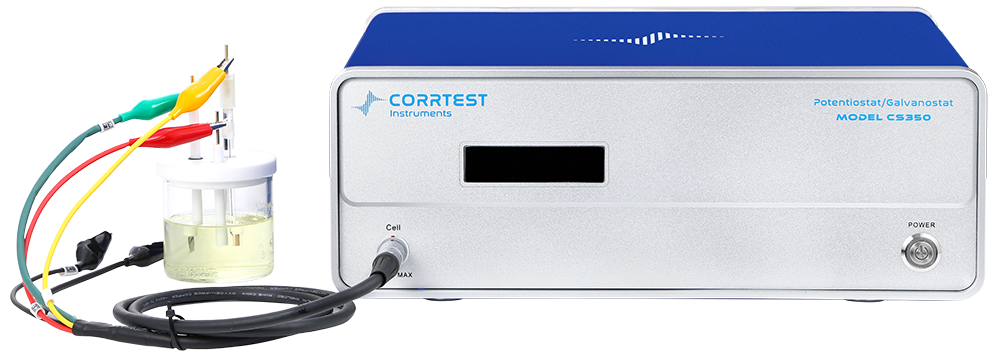
-1(1).png)
Application
●Study of Energy materials (Li-ion battery, solar cell, fuel cell, supercapacitors), advanced functional materials
● Bioelectrochemistry, sensors, electrosynthesis, electrodeposition (electroplating), anodic oxidation, electrolysis
● Electrocatalysis (HER, OER, ORR, CO2RR, NRR)
● Corrosion study and corrosion resistance evaluation of metals; quick evaluation of corrosion inhibitors, coatings, and cathodic protection efficiency
Corrosion Electrochemistry
CS potentiostats/galvanostats support a variety of electrochemical techniques for corrosion, such as OCP recorder, potentiodynamic, EIS, cyclic polarization (CPP), LPR, hydrogen diffusion test, zero resistance ammeter (ZRA), electrochemical noise (ECN), etc.
Due to their high input impedance(1013Ω), they are especially suitable for EIS measurement of high-impedance systems like coating, concrete, and pure water.
.png)

Polarization curve of Ti-based amorphous alloy & stainless steel in 3%NaCl solution
ECN of low-carbon steel in 0.05mol/LCl+0.1mol/LNaHCO3
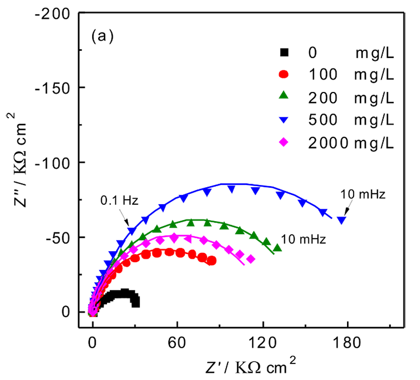
Salt spray aging test of high impedance coating
Energy & Battery testing
With versatile functions like linear sweep voltammetry (LSV), cyclic voltammetry (CV), galvanostatic charge/discharge (GCD), EIS (including potentiostatic and galvanostatic modes) with precise IR compensation, CS potentiostats are widely used in supercapacitor, Li-ion batteries, Li-S batteries, fuel cell, solar cell, solid-state batteries, flow batteries, and metal-air batteries, etc.
.jpg)
CV curve of PPy supercapacitor in 0.5 mol/L H2SO4 solution
Analytical Electrochemistry
CS potentiostats include comprehensive voltammetric methods such as NPV, DPV, DNPV, SWV, and ACV, which make them ideal for quantitative analysis of trace elements via the intrinsic Voltammetry stripping techniques.
.png)
Stripping voltametric curves in solution of different Pb2+, Cd 2+,Zn2+ concentration
Electrocatalysis
Based on CV and LSV techniques, CS potentiostats can carry out long-term tests for ORR, OER, HER, and CO2 reduction, which is crucial for evaluating catalyst stability. In addition, the CS2350M bi-potentiostat and multichannel potentiostat specialize in Faradaic efficiency synchronous measurement.
CS potentiostats can measure the half-wave potential (ORR) and overpotential (HER, OER) of catalysts and calculate the power density and energy density of Redox peaks.
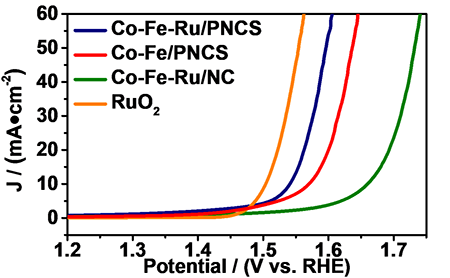
LSV curve of catalysts in alkaline solution
Electrochemical Sensor
Thanks to the high current sensitivity(100fA) and voltage resolution(1 mV), the CS potentiostat can be used for the R&D of biosensors and electrochemical sensors.
Technical Advantages
Switchable floating and earthing mode
All CS potentiostats/galvanostats can switch between the floating and earthing modes, and this strategy is beneficial for studying electrochemical systems in which the working electrodes are intrinsically ground, such as autoclaves, in-site concrete structures and multi-working electrodes requiring isolation, etc.
High-bandwidth EIS
With the help of built-in digital FRA and arbitrary signal generator, as well as the high input impedance (1013 W), the CS potentiostat is particularly suitable for EIS measurements of high-impedance systems (such as coating, membrane, concrete, etc.)
Based on the DC bias compensation technique, CS potentiostats can conduct EIS tests under different charge/discharge states of batteries, making them suitable for ultra-low resistance systems, such as power batteries, fuel cells, water-splitting equipment, etc.
Multi electrode configurations
CS potentiostats support 2-, 3-, or 4-electrode configurations and can measure the galvanic current via built-in zero resistance ammeter circuits.
Independent multiple channels
For CS 310X multi-channel potentiostat, each channel is completely independent. It can be used for the electrochemistry measurements of multiple cells or multiple working electrodes in a cell.
CS2350M Bipotentiostat/multi-channel potentiostat can be used for the RRDE test, dual-cell hydrogen diffusion test.
User-defined sequence test
CS Studio 6.0 for Windows software supports user-defined sequence tests (“combination test”), which can facilitate automatic testing according to user-defined experiment sequences.
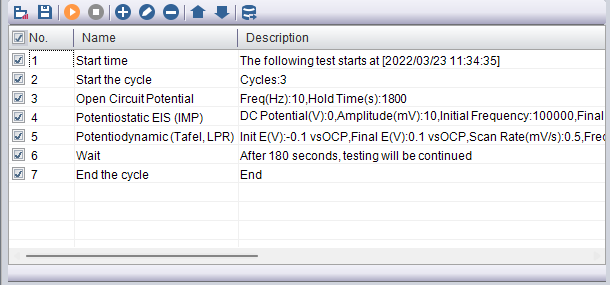
Sequence Test: corrosion tests

Sequence Test: Pseudocapacitor tests
Power booster
Through CS2020B/CS2040B/CS2100B booster, the CS potentiostats can extend their output current up to ±20A/40A/100A, meeting the growing requirements in fuel cells, power batteries, electroplating etc
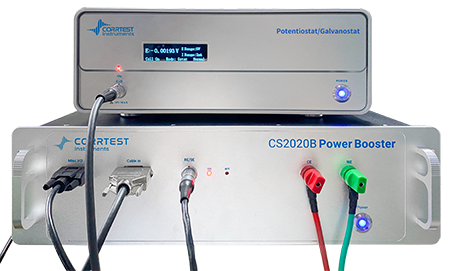
The compliance voltage of single-channel potentiostat can be customized(±30V),suitable for carbon/nitrogen electrochemical reduction.
With a multiplexer, the CS single-channel potentiostats can be extended to 16~32 channels for high throughput testing.
CS potentiostats can work with a CST520 arrayed electrode mapper to study the non-uniform corrosion of metal samples under deposits, coatings and anti-rust oils.
Software development kit(SDK)
All CS potentiostats run under the control of CS Studio 6.0 for Windows (CSS 6.0). The CSS6.0 supports third-party languages, such as LabVIEW, C, C++, C#, VC, Python and others. Some API general interfaces and development examples can be supplied with the CS potentiostats. Through the SDK, customers can implement user-defined test methods.
Real-time data storage
CSS 6.0 saves experimental data timely, even if the experiment is accidentally interrupted by a power failure or computer shutdown. CSS 6.0 supports several data formats compatible with Originpro and Microsoft Excel.
Versatile data analysis
CSS 6.0 provides robust functions, including various electrochemical measurements and data analysis. It can complete Tafel plot fitting, CV derivation, integration and peak height analysis, EIS equivalent circuit fitting, etc.
3, 4 parameter polarization curve fitting.
EIS fitting
Electrochemical noise spectrum analysis
Pseudo-capacitance calculation
GCD-specific capacitance, efficiency calculation
Mott-Schottky analysis
CV curve analysis
Activation/re-passivation curve analysis
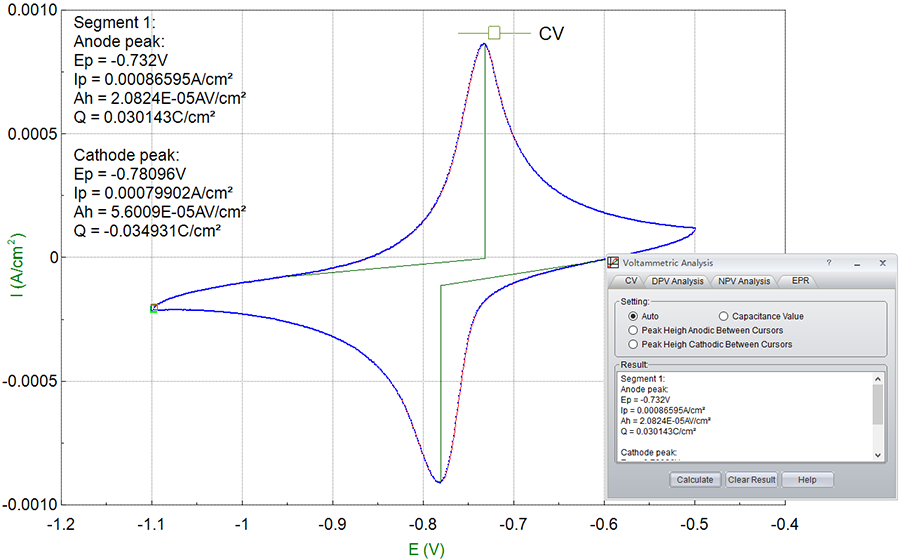
Software Features
Cyclic voltammetry:
CS studio software provides users a versatile smoothing/differential/ integration kit, which can complete the calculation of peak height, peak area and peak potential of CV curves. In CV technique, during the data analysis, there is function of selecting exact cycle(s) to show. You can choose to see a cycle or some cycles as you want. You can also export data or vector graph of an exact cycle or several cycles.
Tafel plot and corrosion rate:
CS studio also provides powerful non-linear fitting on Butler-Volmer equation of polarization curve. It can calculate Tafel slope, corrosion current density, limitation current, polarization resistance, corrosion rate. It can also calculate the power spectrum density, noise resistance and noise spectrum resistance based on the electrochemical noise measurements.

Battery Test and analysis:
charge & discharge efficiency, capacity, specific capacitance, charge & discharge energy.

EIS analysis: Bode, Nyquist, Mott-Schottky plot
During EIS data analysis, there is built-in fitting function to draw the custom equivalent circuit.
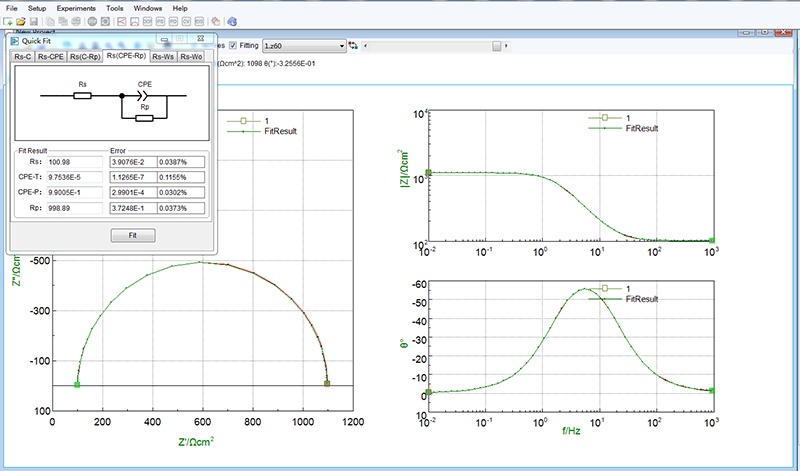
| Specifications | |
| Support 2-, 3- or 4-electrode system | Potential and current range: Automatic |
| Potential control range: ±10V(can be customized to ±12V) | Current control range: ±2A |
| Potential control accuracy: 0.1%×full range±1mV | Current control accuracy: 0.1%×full range |
| Potential resolution: 10μV (>100Hz),3μV (<10Hz) | Current sensitivity:1pA |
| Rise time: <1μS (<10mA), <10μS (<2A) | Reference electrode input impedance:1012Ω||20pF |
| Current range: 2nA~2A, 10 ranges | Compliance voltage: ±21V |
| Maximum current output: 2A | CV and LSV scan rate: 0.001mV~10,000V/s |
| CA and CC pulse width: 0.0001~65,000s | Current increment during scan: 1mA@1A/ms |
| Potential increment during scan: 0.076mV@1V/ms | SWV frequency: 0.001~100 kHz |
| DPV and NPV pulse width: 0.0001~1000s | AD data acquisition:16bit@1 MHz,20bit@1 kHz |
| DA Resolution:16bit, setup time:1μs | Minimum potential increment in CV: 0.075mV |
| IMP frequency: 10μHz~1MHz | Low-pass filters: covering 8-decade |
| Operating System: Windows 10/11 | Interface: USB 2.0 |
| Weight / Measurements: 6.5kg, 36.5 x 30.5 x16 cm | |
| EIS (Electrochemical Impedance Spectroscopy) | |
| Signal generator | |
| Frequency range:10μHz~1MHz | AC amplitude: 0.1mV~2500mV |
| DC Bias: -10~+10V | Output impedance: 50Ω |
| Waveform: sine wave, triangular wave and square wave | Wave distortion: <1% |
| Scanning mode: logarithmic/linear, increase/decrease | |
| Signal analyzer | |
| Integral time: minimum:10ms or the longest time of a cycle | Maximum:106 cycles or 105s |
| Measurement delay: 0~105s | |
| DC offset compensation | |
| Potential automatic compensation range: -10V~+10V | Current compensation range: -1A~+1A |
| Bandwidth: 8-decade frequency range, automatic and manual setting | |

CS300M Potentiostat includes all the techniques for voltammetry

Single-channel potentiostat/galvanostat with EIS Model CS360 consists of a DDS arbitrary function generator, a potentiostat /galvanostat and an FRA. With the help of built-in dual 24-bit Delta-sigma AD converters, it achieves excellent stability and high potential (1mV) and current(1pA) resolutions.With EIS frequency up to be 8MHz, CS360 has been an ideal tool for the study of solid-state electrolyte.
Applications
– Energy materials (Solid-state battery, Li-ion battery, solar cell, fuel cell, supercapacitors, etc)
– Electrocatalysis (HER, OER, ORR, CO2RR, NRR, water splitting)
– Reactive mechanisms of electrosynthesis, electrodeposition (electroplating), anodic oxidation, electrolysis
– Metallic corrosion; corrosion inhibitor, coating and cathodic protection efficiency

With virtues of high energy density, fast charging &discharging, and long lifespan, solid-state batteries are widely used in electric vehicles, wearable devices and so on. Featured by leak-proofness, flame retardancy and inhibition of dendrite growth, solid-state electrolytes enhance the safety of batteries. ElS is an important technique to study the performance of solid-state batteries. It can provide information about charge transfer, electrochemical reactions, etc by measuring EIS in various frequency regions, further providing important theoretical basis and technical support for the development of high-performance fully solid-state batteries.
The EIS frequency can be up to 8MHz for CS360 electrochemical workstation, which can meet the need of high-frequency EIS test on solid electrolytes. Study of solid electrolytes especially focus on impedance behavior in high-frequency region. It helps us to quantify the electronic &ionic conductivity, find microstructural problems of the material (such as grain boundary effects), and thus provide guidance on material optimization, and battery performance improvement.

Solid-state battery holder

Waveform of the EIS test
Specifications – CS360
Support 2-, 3- or 4-electrode configuration
Maximum applied Potential: ±10V
Maximum output current: ±2A
Potential control accuracy: 0.1%×full range±1mV
Current control accuracy: 0.1%×full range
Potential resolution: 1μV
Current sensitivity:1pA
Potential rise time: ≤1μs
Reference electrode input impedance:1013Ω||5pF
Input basis current: ≤10pA
Potential range: ±200mV, ±2.5V, ±5V, ±10V, 4 ranges
Current range: ±200pA ~ ±2 A, 11 ranges
Compliance voltage: ±30V
CV and LSV scan rate: 0.001mV/s~10kV/s
CA and CC pulse width: 0.0001~65,000s
Current increment during scan: 1mA@1A/ms
Potential increment during scan: 0.02mV @1V/ms
SWV frequency: 0.001~100kHz
DPV and NPV pulse width: 0.001~100s
AD data acquisition: 16bit@1MHz, 20bit @1kHz
DA Resolution: 20 bit
Minimum Potential increment in CV: 0.02mV
Low-pass filters: covering 7-decade
Potential and current range: Manual/Auto switch
Ground mode: Floating, Earthing, supports ZRA
Communication: USB2.0, RJ45 Ethernet
Operating System: Windows 10/11
Power supply: 90~240V AC 50/60Hz
Weight / Dimensions : 6.5kg, 36 x 30 x16 cm
EIS (Electrochemical Impedance Spectroscopy)
Signal generator
Frequency range:10μHz~8 MHz
AC amplitude: 1mV~2500mV
DC Bias: -10~+10V
DDS output impedance: 50Ω
Frequency accuracy: 0.1%
Signal resolution: 0.1mV RMS
Waveform: sine wave, triangular wave and square wave
Wave distortion: <1%
Scanning mode: logarithmic/linear, increase/decrease
Signal analyzer
Integral time: minimum:10ms or the longest time of a cycle
Maximum:106 cycles or 105 s
Measurement delay: 0~105s
DC offset compensation
Potential automatic compensation range: -10V~+10V
Current compensation range: -2A~+2A
Bandwidth: 8-decade frequency range, automatic and manual setting
Techniques
Stable polarization:
Open Circuit Potential (OCP)
Potentiostatic (I-T curve)
Galvanostatic
Potentiodynamic (Tafel plot)
Galvanodynamic (DGP)
Transient Polarization:
Multi Potential Steps
Multi Current Steps
Potential Stair-Step (VSTEP)
Galvanic Stair-Step (ISTEP)
Chrono Method:
Chronopotentiometry (CP)
Chronoamperametry (CA)
Chronocaulometry (CC)
Voltammetry:
Linear Sweep Voltammetry (LSV)
Cylic Voltammetry (CV)
Staircase Voltammetry (SCV)
Square Wave Voltammetry (SWV)
Differential Pulse Voltammetry (DPV)
Normal Pulse Voltammetry (NPV)
Differential Normal Pulse Voltammetry (DNPV)
AC Voltammetry (ACV)
2nd harmonic AC Voltammetry (SHACV)
Fourier Transform AC Voltammetry (FTACV)
Electrochemical Impedance Spectroscopy:
Potentiostatic EIS (Nyquist, Bode)
Galvanostatic EIS
Potentiostatic EIS (Optional freq.)
Galvanostatic EIS(Optional freq.)
Mott-Schottky
Potentiostatic EIS vs. Time (Single freq.)
Galvanostatic EIS vs. Time (Single freq.)
Corrosion Measurements:
Cyclic polarization curve (CPP)
Linear polarization curve (LPR)
Electrochemical Potentiokinetic Reactivation (EPR)
Electrochemical Noise (ECN)
Zero resistance Ammeter (ZRA)
Battery testing:
Battery Charge and Discharge
Galvanostatic Charge and Discharge (GCD)
Potentiostatic Charging and Discharging (PCD)
Potentiostatic Intermittent Titration Technique (PITT)
Galvanostatic Intermittent Titration Technique (GITT)
Amperometric:
Differential Pulse Amperometry (DPA)
Double Differential Pulse Amperometry (DDPA)
Triple Pulse Amperometry (TPA)
Integrated Pulse Amperometric Detection (IPAD)
Stripping Voltammetry:
Potentiostatic Stripping,
Linear Stripping,Staircase Stripping
Square Wave Stripping
Differential Pulse Voltammetry Stripping
Normal Pulse Voltammetry Stripping
Differential Normal Pulse Voltammetry Stripping
Extensions:
Electrochemical Stripping/ Deposition
Bulk Eletrolysis with Coulometry (BE)
Rs Measurement


Option B: 4-channel potentiostat. EIS is included on all 4 channels
Corrtest Multichannel potentiostat/ galvanostat/EIS is a versatile instrument offering 8 slots.
Multichannel potentiostat/ galvanostat model CS310X (Option B) is the 4-channel potentiostat. And you have 4 slots occupied with potentiostat boards and 4 slots idle for adding potentiostat board(s) to expand channels in the future. It equals that you can have 4 sets potentiostat/galvanostat, and they’re integrated in one chassis independently.
EIS module (10μHz~1MHz) is equipped all 4 channels. Each channel potential control range is ±10V, current control range ±1A, can meet experiment requirement for most people.
Full floating module and electrical isolation design guarantee each channel is totally independent, which ensures accurate data and efficient simultaneous measurements.
Multichannel potentiostat brings convenience to those who have many samples, and is an ideal device for studies of energy materials, battery study, metal corrosion etc.
.png)
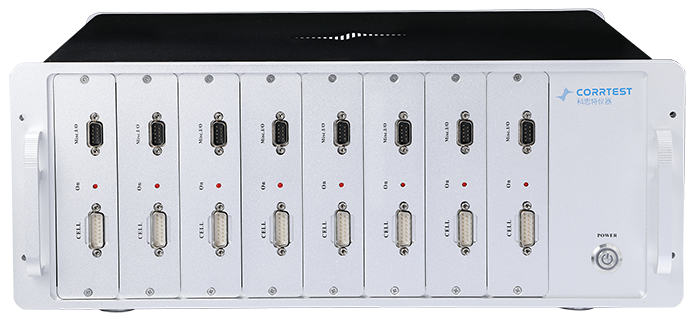
The number of channels is expandable by adding and installing more boards, thanks to the intelligent chassis and plug-in design.
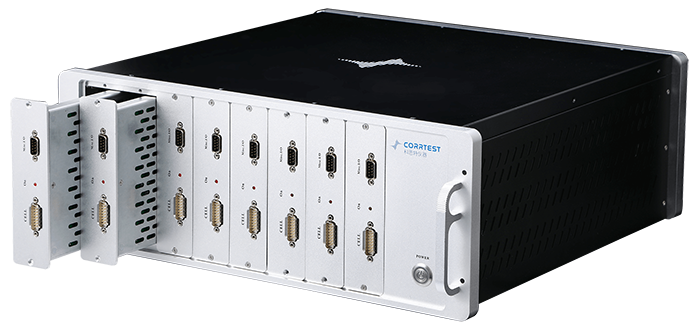
Applications
(1) Reaction mechanism of Electrosynthesis, electrodeposition (electroplating), anodic oxidation, etc.
(2) Electrochemical analysis and sensor;
(3) New energy materials, advanced functional materials, photoelectronic materials;
(4) Corrosion study of metals in water, concrete and soil etc;
(5) Fast evaluation of corrosion inhibitor, water stabilizer, coating and cathodic protection efficiency.
Advantages
High current/voltage: Applied potential range ±10V, current ±1A. It can meet the needs of most studies.
Comprehensive techniques: Built-in EIS (10μHz~1MHz) is equipped in all the 4 channels for Option B. There are comprehensive techniques in each channel.
Warranty: 5 years warranty. We’re the manufacturer, and our engineers will provide technical support anytime you need.
Low cost: The price includes instrument host, software (experiment control & data processing), necessary cables, dummy cell. No other charges.
Simultaneous Measurements
In each channel, the customer can conduct an experiment in each channel at the same time. This is especially useful if you have multi samples to be tested, and it will reduce your time greatly.
You can run a same experiment for each channel at the same time. Set the same parameters for each experiment once and run all independently. It’s especially useful when you have many samples for one single test.
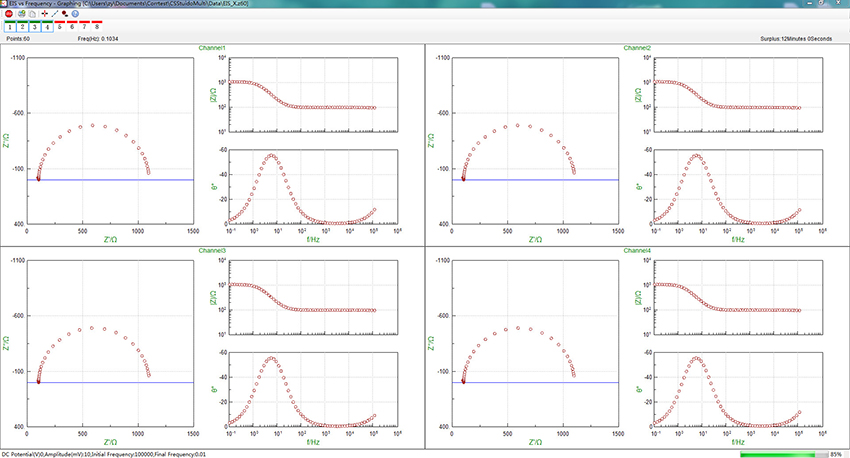
You can also choose different experiment in each channel. Set the parameters for each experiment, and run each experiment independently.
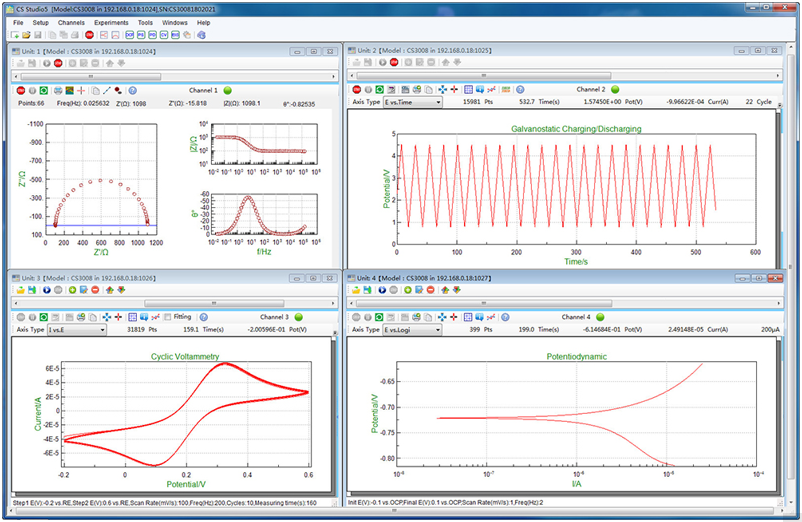
| Specifications | |
| Support 2-, 3- or 4-electrode system | Interface: Ethernet |
| Potential control range: Primary Channel: ±10V second Channel: ±10V | Current control range: ±1A for each channel |
| Potential control accuracy: 0.1%×full range±1mV | Current control accuracy: 0.1%×full range |
| Potential resolution: 10μV (>100Hz), 3μV (<10Hz) | Current sensitivity:1pA |
| Rise time: <1μS (<10mA), <10μS (<2A) | Reference electrode input impedance: 1012Ω||20pF |
| Current range: 2nA~2A, 10 ranges | Compliance voltage: ±21V |
| Maximum current output: ±1A for each channel | CV and LSV scan rate: 0.001mV~10,000V/s |
| CA and CC pulse width: 0.0001~65,000s | Current increment during scan: 1mA@1A/ms |
| Potential increment during scan: 0.076mV@1V/ms | SWV frequency: 0.001~100 kHz |
| DPV and NPV pulse width: 0.0001~1000s | AD data acquisition:16bit@1 MHz,20bit@1 kHz |
| DA Resolution:16bit, setup time:1μs | Minimum potential increment in CV: 0.075mV |
| IMP frequency: 10μHz~1MHz | Low-pass filters: Covering 8-decade |
| Potential and current range: Automatic | Weight / Measurements: 8kg,36.5 x 30.5 x16cm |
| Operating System: Windows 10/11 | |
| Electrochemical Impedance Spectroscopy (EIS) | |
| Signal generator | |
| Frequency range:10μHz~1MHz | AC amplitude:1mV~2500mV |
| DC Bias:-10~+10V | Output impedance:50Ω |
| Waveform: sine wave, triangular wave and square wave | Wave distortion:<1% |
| Scanning mode: logarithmic/linear, increase/decrease | |
| Signal analyzer | |
| Integral time:minimum: 10ms or the longest time of a cycle | Maximum:106 cycles or 105s |
| Measurement delay:0~105s | |
| DC offset compensation | |
| Potential auto compensation range: -10V~+10V | Current compensation range: -1A~+1A |
| Bandwidth: 8-decade frequency range, automatic and manual setting | |

CS300M Potentiostat includes all the techniques for voltammetry

Single-channel potentiostat/galvanostat with EIS Model CS360 consists of a DDS arbitrary function generator, a potentiostat /galvanostat and an FRA. With the help of built-in dual 24-bit Delta-sigma AD converters, it achieves excellent stability and high potential (1mV) and current(1pA) resolutions.With EIS frequency up to be 8MHz, CS360 has been an ideal tool for the study of solid-state electrolyte.
Applications
– Energy materials (Solid-state battery, Li-ion battery, solar cell, fuel cell, supercapacitors, etc)
– Electrocatalysis (HER, OER, ORR, CO2RR, NRR, water splitting)
– Reactive mechanisms of electrosynthesis, electrodeposition (electroplating), anodic oxidation, electrolysis
– Metallic corrosion; corrosion inhibitor, coating and cathodic protection efficiency

With virtues of high energy density, fast charging &discharging, and long lifespan, solid-state batteries are widely used in electric vehicles, wearable devices and so on. Featured by leak-proofness, flame retardancy and inhibition of dendrite growth, solid-state electrolytes enhance the safety of batteries. ElS is an important technique to study the performance of solid-state batteries. It can provide information about charge transfer, electrochemical reactions, etc by measuring EIS in various frequency regions, further providing important theoretical basis and technical support for the development of high-performance fully solid-state batteries.
The EIS frequency can be up to 8MHz for CS360 electrochemical workstation, which can meet the need of high-frequency EIS test on solid electrolytes. Study of solid electrolytes especially focus on impedance behavior in high-frequency region. It helps us to quantify the electronic &ionic conductivity, find microstructural problems of the material (such as grain boundary effects), and thus provide guidance on material optimization, and battery performance improvement.

Solid-state battery holder

Waveform of the EIS test
Specifications – CS360
Support 2-, 3- or 4-electrode configuration
Maximum applied Potential: ±10V
Maximum output current: ±2A
Potential control accuracy: 0.1%×full range±1mV
Current control accuracy: 0.1%×full range
Potential resolution: 1μV
Current sensitivity:1pA
Potential rise time: ≤1μs
Reference electrode input impedance:1013Ω||5pF
Input basis current: ≤10pA
Potential range: ±200mV, ±2.5V, ±5V, ±10V, 4 ranges
Current range: ±200pA ~ ±2 A, 11 ranges
Compliance voltage: ±30V
CV and LSV scan rate: 0.001mV/s~10kV/s
CA and CC pulse width: 0.0001~65,000s
Current increment during scan: 1mA@1A/ms
Potential increment during scan: 0.02mV @1V/ms
SWV frequency: 0.001~100kHz
DPV and NPV pulse width: 0.001~100s
AD data acquisition: 16bit@1MHz, 20bit @1kHz
DA Resolution: 20 bit
Minimum Potential increment in CV: 0.02mV
Low-pass filters: covering 7-decade
Potential and current range: Manual/Auto switch
Ground mode: Floating, Earthing, supports ZRA
Communication: USB2.0, RJ45 Ethernet
Operating System: Windows 10/11
Power supply: 90~240V AC 50/60Hz
Weight / Dimensions : 6.5kg, 36 x 30 x16 cm
EIS (Electrochemical Impedance Spectroscopy)
Signal generator
Frequency range:10μHz~8 MHz
AC amplitude: 1mV~2500mV
DC Bias: -10~+10V
DDS output impedance: 50Ω
Frequency accuracy: 0.1%
Signal resolution: 0.1mV RMS
Waveform: sine wave, triangular wave and square wave
Wave distortion: <1%
Scanning mode: logarithmic/linear, increase/decrease
Signal analyzer
Integral time: minimum:10ms or the longest time of a cycle
Maximum:106 cycles or 105 s
Measurement delay: 0~105s
DC offset compensation
Potential automatic compensation range: -10V~+10V
Current compensation range: -2A~+2A
Bandwidth: 8-decade frequency range, automatic and manual setting
Techniques
Stable polarization:
Open Circuit Potential (OCP)
Potentiostatic (I-T curve)
Galvanostatic
Potentiodynamic (Tafel plot)
Galvanodynamic (DGP)
Transient Polarization:
Multi Potential Steps
Multi Current Steps
Potential Stair-Step (VSTEP)
Galvanic Stair-Step (ISTEP)
Chrono Method:
Chronopotentiometry (CP)
Chronoamperametry (CA)
Chronocaulometry (CC)
Voltammetry:
Linear Sweep Voltammetry (LSV)
Cylic Voltammetry (CV)
Staircase Voltammetry (SCV)
Square Wave Voltammetry (SWV)
Differential Pulse Voltammetry (DPV)
Normal Pulse Voltammetry (NPV)
Differential Normal Pulse Voltammetry (DNPV)
AC Voltammetry (ACV)
2nd harmonic AC Voltammetry (SHACV)
Fourier Transform AC Voltammetry (FTACV)
Electrochemical Impedance Spectroscopy:
Potentiostatic EIS (Nyquist, Bode)
Galvanostatic EIS
Potentiostatic EIS (Optional freq.)
Galvanostatic EIS(Optional freq.)
Mott-Schottky
Potentiostatic EIS vs. Time (Single freq.)
Galvanostatic EIS vs. Time (Single freq.)
Corrosion Measurements:
Cyclic polarization curve (CPP)
Linear polarization curve (LPR)
Electrochemical Potentiokinetic Reactivation (EPR)
Electrochemical Noise (ECN)
Zero resistance Ammeter (ZRA)
Battery testing:
Battery Charge and Discharge
Galvanostatic Charge and Discharge (GCD)
Potentiostatic Charging and Discharging (PCD)
Potentiostatic Intermittent Titration Technique (PITT)
Galvanostatic Intermittent Titration Technique (GITT)
Amperometric:
Differential Pulse Amperometry (DPA)
Double Differential Pulse Amperometry (DDPA)
Triple Pulse Amperometry (TPA)
Integrated Pulse Amperometric Detection (IPAD)
Stripping Voltammetry:
Potentiostatic Stripping,
Linear Stripping,Staircase Stripping
Square Wave Stripping
Differential Pulse Voltammetry Stripping
Normal Pulse Voltammetry Stripping
Differential Normal Pulse Voltammetry Stripping
Extensions:
Electrochemical Stripping/ Deposition
Bulk Eletrolysis with Coulometry (BE)
Rs Measurement
| Specifications | |
| Number of channels: 4 | Channel insulation resistance: >100MΩ |
| Communication: Ethernet | Lower-pass filter: covering 8-decade |
| Potential control range: ±10V | Constant current control range: ±1A |
| Potential accuracy: 0.1%×full range±1mV | Current accuracy: 0.1%×full range |
| Potential resolution:10μV(>100Hz), 3μV(<10Hz) | Current resolution: 1pA |
| Potential rise time: ﹤1μs(<10mA),<10μs(<2A) | Current range: 2nA ~1A |
| Reference electrode input impedance: 1012Ω||20pF | Maximum current output: ± 1A |
| Compliance: ±12V | Current increment during scan: 1mA @1A/ms |
| CV and LSV scan rate: 0.001mV~10000V/s | Potential increment during scan: 0.076mV@1V/ms |
| CA and CC pulse width: 0.0001~65000s | DPV and NPV pulse width: 0.0001~1000s |
| SWV frequency:0.001~100KHz | CV minimum potential increment: 0.075mV |
| AD data acquisition: 16bit@1MHz,20bit @1kHz | IMP frequency:10μHz~1MHz |
| DA resolution:16bit, setup time:1μs | Current and potential range: automatic |
| Operating System requirements: Windows 10/11 | Weight: 12Kg |
| Electrochemical Impedance Spectroscopy(EIS) | |
| Signal generator | |
| Frequency range:10μHz~1MHz | AC signal amplitude: 1mV~2500mV |
| Frequency accuracy:0.005% | Signal resolution: 0.1mV RMS |
| DDS output impedance: 50Ω | DC Bias: -10V~+10V |
| Wave distortion: <1% | Waveform: sine wave, triangular wave, square wave |
| Scan mode: Logarithmic/linear, increase/decrease | |
| Signal analyzer | |
| Maximum integral time:106 cycles or 105s | Measurement delay:0~105S |
| Minimum integral time:10ms or the longest time of a cycle | |
| DC offset compensation | |
| Potential compensation range: -10V~+10V | Current compensation range: -1A~+1A |
| Bandwidth adjustment: automatic and manual, 8-decade frequency range | |


Option D: 8-channel, with EIS included on all 8 channels
Corrtest Multichannel potentiostat/ galvanostat/EIS is a versatile instrument offering 8 slots.
Multichannel potentiostat/ galvanostat model CS310X (Option D) is the 8-channel potentiostat. And all the slots are occupied with potentiostat boards. It equals that you can have 8 sets independent potentiostat/galvanostat, and they’re integrated in one chassis.
EIS module (10μHz~1MHz) is equipped in all the 8 channel. Each channel potential control range is ±10V, current control range ±1A, can meet experiment requirement for most people.
Full floating module and electrical isolation design guarantee each channel is totally independent, which ensures accurate data and efficient simultaneous measurements.
Multichannel potentiostat brings convenience to those who have many samples, and is an ideal device for studies of energy materials, battery study, metal corrosion etc.
.png)
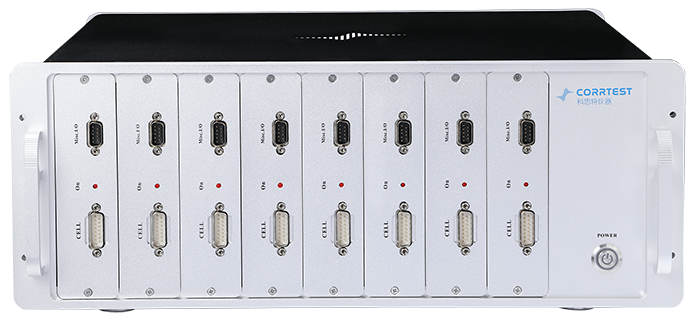
Advantages
High current/voltage: Applied potential range ±10V, current ±1A. It can meet the needs of most studies.
Comprehensive techniques: Built-in EIS (10μHz~1MHz) is equipped in all the 8 channels. There are comprehensive techniques in each channel.
Warranty: 5 years warranty. We’re the manufacturer, and our engineers will provide technical support anytime you need.
Low cost: The price includes instrument host, software (experiment control & data processing), necessary cables, dummy cell. No other charges.
Reliability &quality: We’ve been in the market for 20 years, and now is the No. 1 brand of potentiostat product in China
Application
– Reaction mechanism of Electrosynthesis, electrodeposition (electroplating), anodic oxidation.
– Electrochemical analysis, electro-catalysis, sensor;
– New energy materials, advanced functional materials, photoelectronic materials;
– Corrosion study of metals in water, concrete and soil etc;
– Fast evaluation of corrosion inhibitor, water stabilizer, coating and cathodic protection efficiency.
Simultaneous Measurements
The customer can choose a same electrochemical technique in every channel. For example, among 8 channels, you can choose to run 4 channels to all do EIS measurement. Set the parameters just one time, then EIS measurement in each channel will be conducted at the same time.(Here is an example of using the 4 channels. You can run the 8 experiments at the same time on one window)
.png)
In each channel, you can also conduct different experiments. As is shown in the below picture, EIS, galvanostatic charge and discharge, CV, and polarization curve tests are conducted at the same time.(Here is an example of using the 4 channels. You can run the 8 experiments at the same time on one window)
.png)
Standard supply for Option D:
Instrument host *1
CS studio software package *1
Power cable * 1,
Ethernet cable *1
Cell/Electrode cable *16 PCS
Dummy cell *8 PCS
After-sales Service (All the service is totally FREE)
1. Warranty period: 5 years.
2. Provide manual, software installation video & training videos.
3. Free repair service
4. Lifetime software upgrading (same model) and technical service.
Techniques in each channel – CS310X Option D
(EIS is included in all the 8 channels)
Stable polarization
Open Circuit Potential (OCP)
Potentiostatic (I-T curve)
Galvanostatic
Potentiodynamic (Tafel plot)
Galvanodynamic (DGP)
Transient Polarization
Multi Potential Steps
Multi Current Steps
Potential Stair-Step (VSTEP)
Galvanic Stair-Step (ISTEP)
Chrono Method
Chronopotentiometry (CP)
Chronoamperametry (CA)
Chronocaulometry (CC)
Voltammetry
Linear Sweep Voltammetry (LSV)
Cylic Voltammetry (CV)
Staircase Voltammetry (SCV)
Square Wave Voltammetry (SWV)
Differential Pulse Voltammetry (DPV)
Normal Pulse Voltammetry (NPV)#
Differential Normal Pulse Voltammetry (DNPV)
AC Voltammetry (ACV)
2nd harmonic AC Voltammetry (SHACV)
Fourier Transform AC Voltammetry (FTACV)
Stripping Voltammetry
Potentiostatic Stripping
Linear Stripping
Staircase Stripping
Square Wave Stripping
Differential Pulse Voltammetry Stripping
Normal Pulse Voltammetry Stripping
Differential Normal Pulse Voltammetry Stripping
Amperometric
Differential Pulse Amperometry (DPA)
Double Differential Pulse Amperometry (DDPA)
Triple Pulse Amperometry (TPA)
Integrated Pulse Amperometric Detection (IPAD)
Electrochemical Impedance Spectroscopy (EIS)
EIS vs Frequency (IMP)
Galvanostatic EIS
EIS vs Potential (IMPE)(Mott-Schottky)
EIS vs Time (IMPT)
Galvanostatic EIS vs Time
Corrosion Measurements
Cyclic polarization curve (CPP)
Linear polarization curve (LPR)
Electrochemical Potentiokinetic Reactivation (EPR)
Electrochemical Noise (EN)
Zero resistance Ammeter (ZRA)
Battery test
Battery Charge and Discharge
Galvanostatic Charge and Discharge (GCD)
Potentiostatic Charging and Discharging(PCD)
Potentiostatic Intermittent Titration Technique (PITT)
Galvanostatic Intermittent Titration Technique (GITT)
Extensions
Electrochemical Stripping/ Deposition
Bulk Eletrolysis with Coulometry (BE)
Rs Measurement

2-channel potentiostat without EIS.

CS2150M Bipotentiostat / Bigalvanostat is the real 2-channel potentiostat. The two channels are totally independent. It can not only support RE, CE, WE 1, WE 2 system, but also supports two independent systems:
System 1#: WE 1, RE 1, CE 1
System 2#: WE 2, RE 2, CE 2
When the bipotentiostat has 2 independent channels, you can connect to 2 independent cell systems, and conduct the experiment at the same time in each channel.
This will save your time and make experiment more efficient especially when you have many samples to be tested.
CS2150M equals to two sets of single-channel potentiostat (Model CS150M) in one chassis. It brings convenience to the researches and save their time. It is a popular cost-effective product among users. With the same level and function product, our price is just half or one third of some other brands.
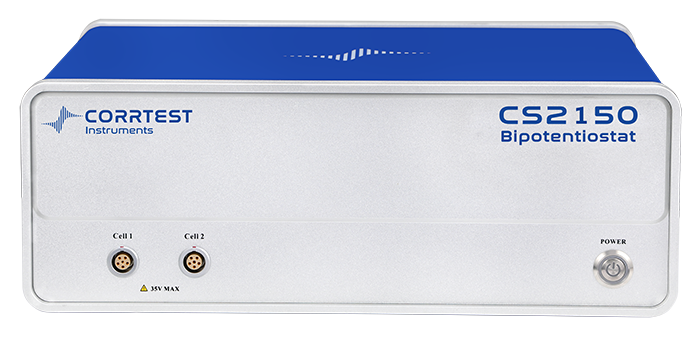
Application
(1) Electrosynthesis, electrodeposition (electroplating), anodic oxidation, electrolysis
(2) Oxygen reduction reaction (ORR), oxygen evolution reaction (OER), Hydrogen evolution reaction (HER), carbon dioxide reduction.
(3) Energy and materials (Li-ion battery, solar cell, fuel cell, supercapacitor), advanced function materials, and sensor.
(4) Corrosion behavior of metals, and anti-corrosion evaluation
(5) Fast evaluation of inhibitor, water quality stabilizer, coating, and cathodic protection efficiency.
Standard supply
Instrument CS2150M x1
CS studio software x1
Power cable x1
Ethernet cable x1
Cell cable x 4
Dummy cell (1kΩ||100µF) x2
After-sales Service (**All the after service is FREE)
1. Warranty period: 5 years.
2. Provide installation guide, manual, software installation video, and training videos.
3. Lifetime free software upgrading of the same model and technical service.
4. Free repair service
Typical applications
Rotating ring-disk electrode (RRDE)
Oxidation/reduction reaction (ORR) study: while measuring the polarization curve of disk electrode in the main channel, apply a constant polarization potential on the ring electrode, and thus detect the intermediate products on the disk electrode. RRDE test becomes the typical method for ORR study.
.png)
.png)
Hydrogen diffusion test (HDT)
CS2150M Bipotentiostats are combined with H-cells. By measuring current of cathode hydrogen charging (the left cell) and hydrogen atoms anode oxidation (the right cell), it can further calculate the diffusion coefficient of hydrogen atoms in metal and hydrogen flux.
.png)
.jpg)
Technical advantages
1. Polarization curve
Tafel plot can be obtained. The user can set the anodic reversal current (passivation film breakdown current) of the cyclic polarization curve to obtain material’s pitting potential and protection potential and uate the its susceptibility to intergranular corrosion. The software uses non-linear fitting to analyze polarization curve, and can make fast evaluation of material’s anti-corrosion ability and inhibitors.
.png)
Polarization curve of Ti-based amorphous alloy & stainless steel in 3%NaCl solution
2. Voltammetry
Linear Sweep Voltammetry(LSV), Cyclic Voltammetry(CV), SCV, SWV, DPV, NPV,ACV, Stripping voltammetry etc. It integrates calculation of peak area, peak current and standard curve analysis.
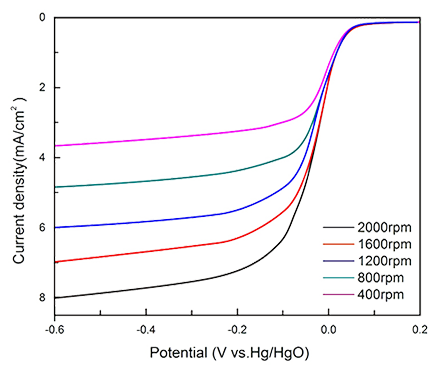
.jpg)
LSV: mesoporous carbon material in 0.1M KOH CV of PPy supercapacitor in 0.5 mol/L H2SO4
3. Electrochemical Noise
With high-resistance follower and zero-resistance ammeter, it measures the natural potential/current fluctuations in corrosion system. It can be used to study pitting corrosion, galvanic corrosion, crevice corrosion, and stress corrosion cracking etc. Based on calculation of noise resistance and pitting index, it can complete localized corrosion monitoring.

4. Full floating measurement
Full-floating mode be used for autoclave electrochemical measurements, on-line corrosion monitoring of metallic components under the ground (rebar in concrete, etc.)
5. Software development kit (SDK)
We are able to provide API functions and development examples, which facilitates some users’ requirements for secondary development and self-defined measurements. We can provide .dll file.
Software Features
Cyclic voltammetry:
CS studio software provides users a versatile smoothing/differential/ integration kit, which can complete the calculation of peak height, peak area and peak potential of CV curves. In CV technique, during the data analysis, there is function of selecting exact cycle(s) to show. You can choose to see a cycle or some cycles as you want. You can also export data or vector graph of an exact cycle or several cycles.
.png)
Tafel plot and corrosion rate:
CS studio also provides powerful non-linear fitting on Butler-Volmer equation of polarization curve. It can calculate Tafel slope, corrosion current density, limitation current, polarization resistance, corrosion rate. It can also calculate the power spectrum density, noise resistance and noise spectrum resistance based on the electrochemical noise measurements.
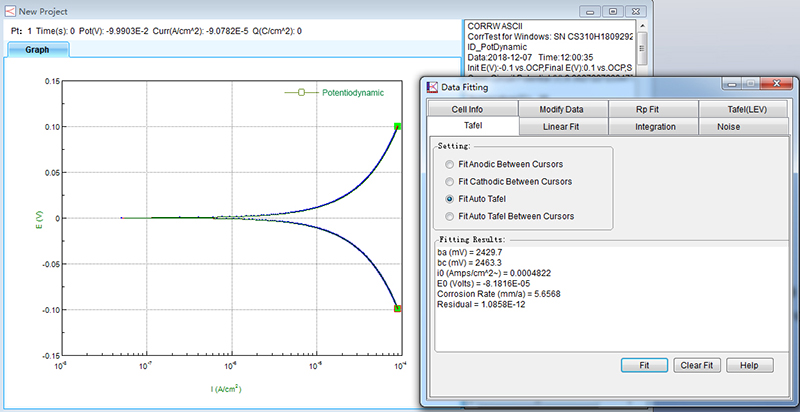
Battery Test and analysis:
charge & discharge efficiency, capacity, specific capacitance, charge & discharge energy.
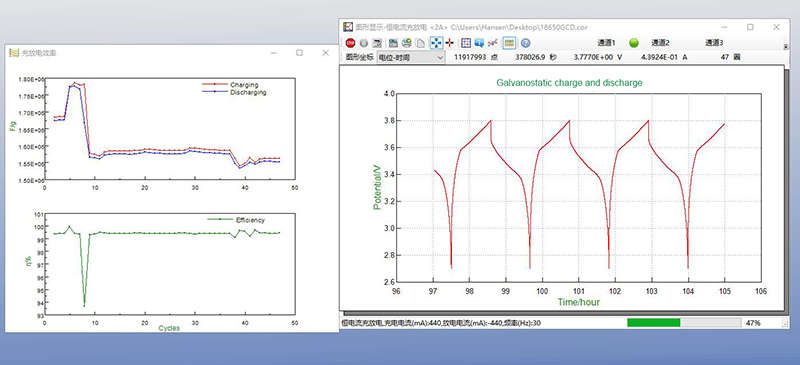
Real time saving of data: The data can be automatically saved even in case of sudden power off.
Combination test: it can facilitate the automation of experiments and save time. With the unique function of combination test, you can choose several techniques, and set the wait time, the start time, and the cycles. Choose the experiments you want to run. Then you can make auto measurement of the set experiments as you want without having to wait in the lab. This function is especially useful if you have multi experiments to run and save your time greatly.

Data open: You can open the data files by txt format in notepad. Data can also be opened in Origin
| Specifications | |
| Support 2-, 3- or 4-electrode system | Interface: Ethernet |
| Potential control range: Primary Channel: ±10V second Channel: ±10V | Current control range: ±1A for each channel |
| Potential control accuracy: 0.1%×full range±1mV | Current control accuracy: 0.1%×full range |
| Potential resolution: 10μV (>100Hz), 3μV (<10Hz) | Current sensitivity:1pA |
| Rise time: <1μS (<10mA), <10μS (<2A) | Reference electrode input impedance:1012Ω||20pF |
| Current range: 2nA~2A, 10 ranges | Compliance voltage: ±21V |
| Maximum current output: ±1A for each channel | CV and LSV scan rate: 0.001mV~10,000V/s |
| CA and CC pulse width: 0.0001~65,000s | Current increment during scan: 1mA@1A/ms |
| Potential increment during scan: 0.076mV@1V/ms | SWV frequency: 0.001~100 kHz |
| DPV and NPV pulse width: 0.0001~1000s | AD data acquisition:16bit@1 MHz,20bit@1 kHz |
| DA Resolution:16bit, setup time:1μs | Minimum potential increment in CV: 0.075mV |
| IMP frequency: 10μHz~1MHz | Low-pass filters: Covering 8-decade |
| Potential and current range: Automatic | Weight / Measurements: 8kg,36.5 x 30.5 x16cm |
| Operating System: Windows 10/11 | |


The combination of a potentiostat and a CS5010B booster can achieve ±10A/50V output current/voltage
Key specifications
Single-channel potentiostat (CS350M/ CS310M/ CS300M etc) can achieve maximum±2A/10V output when it’s used alone.
It’s ±1A/10V for each channel of bipotentiostat (CS2350M/CS2150M) and multichannel potentiostat (CS310X).
When it requires higher current and higher applied voltage, we have power booster to meet this requirement.
The combination of a potentiostat and a CS5010B booster can achieve ±10A/50V output current/voltage.
-The combination is for applications of fuel cell, water splitting, cylindrical cell,pouch battery, and battery cell testing, etc.
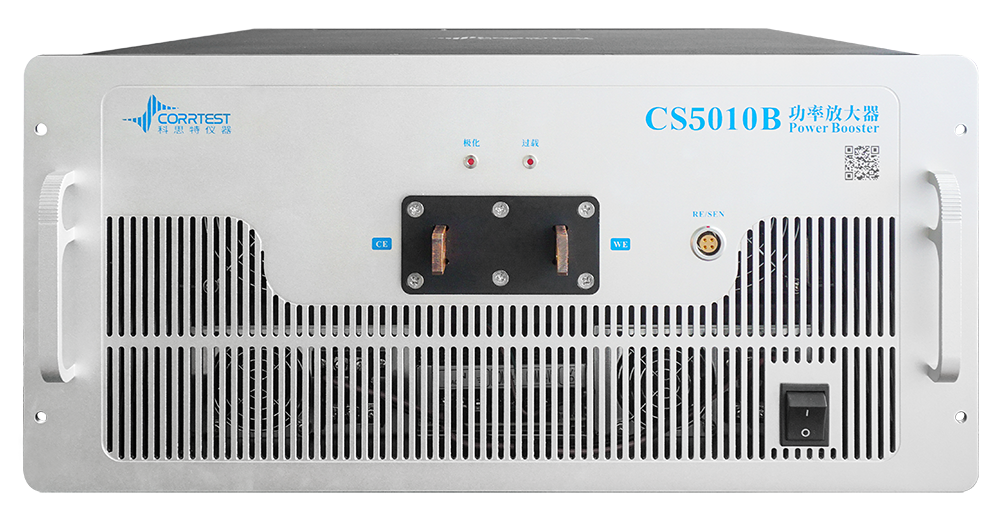
Key specifications
Maximum applied current: ±10A (AC/DC)
Maximum applied potential: ±50V
Current range: 10A fixed
Compliance voltage: ±50V
EIS frequency range: 1μHZ~10kHz
Communication: RS485
Techniques
The techniques of the combination depends on the potentiostat that CS5010B connects to. A full-featured potentiostat includes the following functionalities:
Stable polarization: Open Circuit Potential (OCP), Potentiostatic (I-T curve), Galvanostatic,Potentiodynamic (Tafel plot), Galvanodynamic (DGP)
Transient Polarization: Multi Potential Steps,Multi Current Steps,Potential Stair-Step (VSTEP),Galvanic Stair-Step (ISTEP)
Chrono Method:Chronopotentiometry (CP), Chronoamperametry (CA), Chronocaulometry (CC)
Voltammetry: Linear Sweep Voltammetry (LSV), Cylic Voltammetry (CV), Staircase Voltammetry (SCV), Square Wave Voltammetry (SWV), Differential Pulse Voltammetry (DPV), Normal Pulse Voltammetry (NPV), Differential Normal Pulse Voltammetry (DNPV), AC Voltammetry (ACV), 2nd harmonic AC Voltammetry (SHACV), Fourier Transform AC Voltammetry (FTACV)
Electrochemical Impedance Spectroscopy: Potentiostatic EIS (Nyquist, Bode), Galvanostatic EIS, Potentiostatic EIS (Optional freq.), Galvanostatic EIS(Optional freq.), Mott-Schottky, Potentiostatic EIS vs. Time (Single freq.), Galvanostatic EIS vs. Time (Single freq.)
Corrosion Measurements: Cyclic polarization curve (CPP), Linear polarization curve (LPR), Electrochemical Potentiokinetic Reactivation (EPR), Electrochemical Noise (EN), Zero resistance Ammeter (ZRA)
Battery testing: Battery Charge and Discharge, Galvanostatic Charge and Discharge (GCD), Potentiostatic Charging and Discharging (PCD), Potentiostatic Intermittent Titration Technique (PITT), Galvanostatic Intermittent Titration Technique (GITT)
Amperometric: Differential Pulse Amperometry (DPA),Double Differential Pulse Amperometry (DDPA),Triple Pulse Amperometry (TPA),Integrated Pulse Amperometric Detection (IPAD)
Stripping Voltammetry:Potentiostatic Stripping,Linear Stripping,Staircase Stripping,Square Wave Stripping,Differential Pulse Voltammetry Stripping,Normal Pulse Voltammetry Stripping,Differential Normal Pulse Voltammetry Stripping
Extensions:Data Logger,Electrochemical Stripping/ Deposition, Bulk Eletrolysis with Coulometry (BE), Rs Measurement
Supply list of CS5010B
– CS5010B instrument
– Power cable
– Connection cable for communication(1.5m)
– Electrode connection cable(1.5m)
– WE/CE copper nose-copper nose electrode cable
– RE/SENSE potential sampling cable
-Tool kit
– High power dummy cell

Single-channel potentiostat (CS350M/ CS310M/ CS300M etc) can achieve maximum±2A/10V output when it’s used alone. A current booster CS2020B/CS2040B/CS2100B can be connected to single-, bi-, or multi-channel potentiostat to increase the current up to 20A/40A/100A

CS2150M Bipotentiostat / Bigalvanostat is the real 2-channel potentiostat. The two channels are totally independent. It can not only support RE, CE, WE 1, WE 2 system, but also supports two independent systems:
System 1#: WE 1, RE 1, CE 1
System 2#: WE 2, RE 2, CE 2
When the bipotentiostat has 2 independent channels, you can connect to 2 independent cell systems, and conduct the experiment at the same time in each channel.
This will save your time and make experiment more efficient especially when you have many samples to be tested.
CS2150M equals to two sets of single-channel potentiostat (Model CS150M) in one chassis. It brings convenience to the researches and save their time. It is a popular cost-effective product among users. With the same level and function product, our price is just half or one third of some other brands.

Application
(1) Electrosynthesis, electrodeposition (electroplating), anodic oxidation, electrolysis
(2) Oxygen reduction reaction (ORR), oxygen evolution reaction (OER), Hydrogen evolution reaction (HER), carbon dioxide reduction.
(3) Energy and materials (Li-ion battery, solar cell, fuel cell, supercapacitor), advanced function materials, and sensor.
(4) Corrosion behavior of metals, and anti-corrosion evaluation
(5) Fast evaluation of inhibitor, water quality stabilizer, coating, and cathodic protection efficiency.
Standard supply
Instrument CS2150M x1
CS studio software x1
Power cable x1
Ethernet cable x1
Cell cable x 4
Dummy cell (1kΩ||100µF) x2
After-sales Service (**All the after service is FREE)
1. Warranty period: 5 years.
2. Provide installation guide, manual, software installation video, and training videos.
3. Lifetime free software upgrading of the same model and technical service.
4. Free repair service
Typical applications
Rotating ring-disk electrode (RRDE)
Oxidation/reduction reaction (ORR) study: while measuring the polarization curve of disk electrode in the main channel, apply a constant polarization potential on the ring electrode, and thus detect the intermediate products on the disk electrode. RRDE test becomes the typical method for ORR study.
.png)
.png)
Hydrogen diffusion test (HDT)
CS2150M Bipotentiostats are combined with H-cells. By measuring current of cathode hydrogen charging (the left cell) and hydrogen atoms anode oxidation (the right cell), it can further calculate the diffusion coefficient of hydrogen atoms in metal and hydrogen flux.
.png)
.jpg)
Technical advantages
1. Polarization curve
Tafel plot can be obtained. The user can set the anodic reversal current (passivation film breakdown current) of the cyclic polarization curve to obtain material’s pitting potential and protection potential and uate the its susceptibility to intergranular corrosion. The software uses non-linear fitting to analyze polarization curve, and can make fast evaluation of material’s anti-corrosion ability and inhibitors.
.png)
Polarization curve of Ti-based amorphous alloy & stainless steel in 3%NaCl solution
2. Voltammetry
Linear Sweep Voltammetry(LSV), Cyclic Voltammetry(CV), SCV, SWV, DPV, NPV,ACV, Stripping voltammetry etc. It integrates calculation of peak area, peak current and standard curve analysis.

.jpg)
LSV: mesoporous carbon material in 0.1M KOH CV of PPy supercapacitor in 0.5 mol/L H2SO4
3. Electrochemical Noise
With high-resistance follower and zero-resistance ammeter, it measures the natural potential/current fluctuations in corrosion system. It can be used to study pitting corrosion, galvanic corrosion, crevice corrosion, and stress corrosion cracking etc. Based on calculation of noise resistance and pitting index, it can complete localized corrosion monitoring.

4. Full floating measurement
Full-floating mode be used for autoclave electrochemical measurements, on-line corrosion monitoring of metallic components under the ground (rebar in concrete, etc.)
5. Software development kit (SDK)
We are able to provide API functions and development examples, which facilitates some users’ requirements for secondary development and self-defined measurements. We can provide .dll file.
Software Features
Cyclic voltammetry:
CS studio software provides users a versatile smoothing/differential/ integration kit, which can complete the calculation of peak height, peak area and peak potential of CV curves. In CV technique, during the data analysis, there is function of selecting exact cycle(s) to show. You can choose to see a cycle or some cycles as you want. You can also export data or vector graph of an exact cycle or several cycles.
.png)
Tafel plot and corrosion rate:
CS studio also provides powerful non-linear fitting on Butler-Volmer equation of polarization curve. It can calculate Tafel slope, corrosion current density, limitation current, polarization resistance, corrosion rate. It can also calculate the power spectrum density, noise resistance and noise spectrum resistance based on the electrochemical noise measurements.

Battery Test and analysis:
charge & discharge efficiency, capacity, specific capacitance, charge & discharge energy.

Real time saving of data: The data can be automatically saved even in case of sudden power off.
Combination test: it can facilitate the automation of experiments and save time. With the unique function of combination test, you can choose several techniques, and set the wait time, the start time, and the cycles. Choose the experiments you want to run. Then you can make auto measurement of the set experiments as you want without having to wait in the lab. This function is especially useful if you have multi experiments to run and save your time greatly.

Data open: You can open the data files by txt format in notepad. Data can also be opened in Origin
Potential range: ±10V(CS2020B) / ±5V(CS2040B) / ±5V(CS2100B)
Current range: ±20A(CS2020B) / 40A(CS2040B) / 100A(CS2100B)
Current range: 20A/40A/100A fixed range
Compliance voltage: ±13V (when output±20A limit current, maximum output ±10V@20A)
EIS Frequency range: ≤50KHz
Communication: RS485


Standard supply Instrument host CS300M x1 CS studio software Power cable x1,USB cable x1,Cell cable x2 Dummy cell(1kΩ||100µF) x1,Manual
CS300M Potentiostat/Galvanostat contains a fast digital function generator, high-speed data acquisition circuitry, a potentiostat and a galvanostat. With high performance in stability and accuracy with advanced hardware and well-functioned software, it is an entery and cost-effective model. With methods such as Potentiodynamic (Tafel plot), it’s widely used to measure pitting corrosion potential
International standards of pitting corrosion potential measurement:
China: GB 4334.9-84
USA: ASTM G61-1986(2014)
Japan: JIS G0577-1981
etc…
Standards
GB/T 17899-1999
GB/T 18590-2001
GB/T 32550-2016
Industry standards
YY/T 1074-2002
YY/T0149-2006
YY/T 0695-2008

Experiment setup


Software parameters’ setting

Typical Pitting potential
| Specifications | |
| Support 2-, 3- or 4-electrode system | Potential and current range: Automatic |
| Potential control range: ±10V | Current control range: ±2A |
| Potential control accuracy:0.1%×full range±1mV | Current control accuracy: 0.1%×full range |
| Potential resolution: 10μV (>100Hz),3μV (<10Hz) | Current sensitivity:1pA |
| Rise time: <1μS (<10mA), <10μS (<2A) | Reference electrode input impedance:1012Ω||20pF |
| Current range: 2nA~2A, 10 ranges | Compliance voltage: ±21V |
| Maximum current output: 2A | CV and LSV scan rate: 0.001mV~10,000V/s |
| CA and CC pulse width: 0.0001~65,000s | Current increment during scan: 1mA@1A/ms |
| Potential increment during scan:0.076mV@1V/ms | SWV frequency: 0.001~100 kHz |
| DPV and NPV pulse width: 0.0001~1000s | AD data acquisition:16bit@1 MHz,20bit@1 kHz |
| DA Resolution:16bit, setup time:1μs | Minimum potential increment in CV: 0.075mV |
| Low-pass filters: covering 8-decade | Operating System: Windows 10/11 |
| Interface: USB 2.0 | Weight / Measurements: 6.5kg, 36.5 x 30.5 x16 cm |

CST520 can quickly map the galvanic current and OCP distribution on an arrayed multi-electrode and facilitate the study of non-uniform corrosion of metal samples under deposits, coatings and anti-rust oils.
Based on high-resolution AD converters and zero resistance ammeter techniques, CST520 can quickly map the galvanic current and OCP distribution on an arrayed multi-electrode and facilitate the study of non-uniform corrosion of metal samples under deposits, coatings and anti-rust oils. Further, it can work with CS potentiostat to map impedance distribution on a multiple-electrode sensor.

Based on high-resolution AD converters and zero resistance ammeter techniques, CST520 can quickly map the galvanic current and OCP distribution on an arrayed multi-electrode and facilitate the study of non-uniform corrosion of metal samples under deposits, coatings and anti-rust oils. Further, it can work with CS potentiostat to map impedance distribution on a multiple-electrode sensor.
By cyclic scanning of the potential and current distribution on the surface of the array electrode, it can characterize the local corrosion distribution or non-uniform electrochemical dissolution process of bare metal or metal under coating.

CST520 can precisely measure the electrode potential and short-circuit current of any single electrode. It is particularly suitable to study the spontaneous corrosion of metals under non-perturbed state.


Application
This instrument is suitable for studying the local corrosion distribution characteristics of metal surfaces in the laboratory, as well as the mechanism study of the occurrence and development of local corrosion. It can be widely used to study metal non-uniform corrosion behavior.
Working principle
CST520 Multi-electrode Array electrochemical system consists of two parts: a multi-electrode interface and an electrochemical testing system. It can not only test the electrode potential and short-circuit current of any single electrode, but also measure the EIS and polarization curve, significantly enriching the evaluation methods of materials’ corrosion resistance.
The multi-electrode interface mainly consists of RS485 communication circuit, IO expansion circuit, 10×10 relay matrix circuit, MCU circuit, etc. It supports up to 100-channel array electrode switching, with switch rate of up to 100Hz.
The Electrochemical mapper can not only conduct array electrode testing, but also serve as an independent potentiostat/electrochemical workstation with all techniques for corrosion measurements, such as open circuit potential (OCP), polarization curve (Tafel), linear polarization (LPR), EIS, M-S curve, and electrochemical noise (ECN) etc.
Potential and current scanning
The CST520 can achieve cyclic potential/ current scan of the surface, or potential/current vs. time scan of any single electrode, with real-time potential/current distribution display. The data can be imported into Origin to display the 3D graphs.

As shown in above picture, it shows the potential/current distribution. It can be seen that there are three areas with more negative potentials. Negative current also appears at the same areas in the current distribution diagram. Negative current means anode current, indicating that more severe corrosion occurs in these three areas on the electrode surface.

Impedance modulus distribution on a 10´10 wire beam electrodes
Standard supply:
CST520 Multi-electrode Array Electrochemical Mapper* 1 set
CS5000X Multi-electrode interface*1 set
Software kit*1
Expansion electrode cable* 3(WE/SE/AGND(WE99))
Reference electrode input cable*1
Counter electrode input cable *1
DB9 communication cable *1
Q235 carbon steel 10*10 array electrode *1
Electrode cable *2
Power cable *2
USB cable*1
Dummy cell *1
Specifications
Potential range: ±10V, ±5V, ±2.5V
Potential control accuracy: 0.1% of Full scale±1mV
Current range:2nA~2 A,10 ranges
Maximum current output: ±2A
Current control accuracy: 0.1% of Full scale
Channel switching rate: 100Hz
Expansion interface: RS485 115200bps
Power supply: AC 220V
Your dedicated partner in providing high-quality laboratory and research equipment. With years of industry experience, we specialize in supplying cutting-edge laboratory instruments, research equipment, and essential lab tools to support scientific discovery, educational advancement, and innovation across various industries.
© 2025 | REIDIUS TECHNOLOGIES | All Rights reserved.